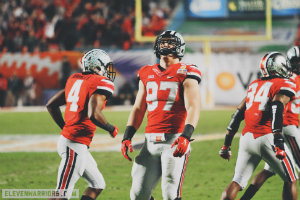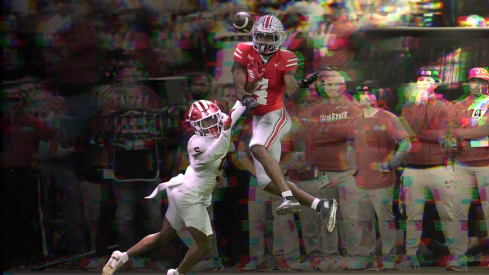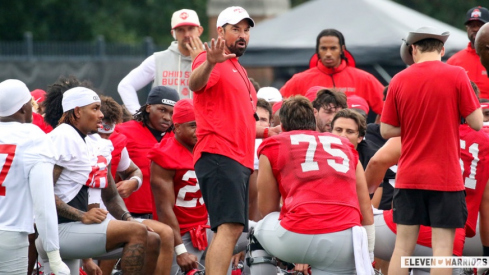
Though favored in Vegas by three points and with the endorsement of most advanced metrics, Clemson's Sammy Watkins and a slew of Buckeye turnovers would ultimately be too much to overcome.
On the one hand, the statistical advantage was real. The F/+ index, possession efficiency metrics, and explosiveness ratings all pointed towards Meyer picking up another BCS victory.
However, the Buckeyes' statistical advantage was slim enough that they needed to play relatively mistake-free football to win. Ultimately, the Buckeyes had a chance to win it up until the final 1:18, when Clemson intercepted Braxton for the last time. Turnovers, and the points off of turnovers, would make the difference when such a high percentage of the game's drives (on both sides) would end in scores.
It may not be fun to subject ourselves to the numbers to Meyer's first bowl loss at Ohio State, but there's also plenty of stellar performances for the team to build on for next season.
| Pts/Play | Yards/Pts | Yards/Play | Pts/Poss | Ex. Play | Turnovers | |
|---|---|---|---|---|---|---|
| Ohio State Offense | .486 | 12.2 | 5.93 | 2.69 | 6 | 4 |
| Ohio State Defense | .526 | 14.4 | 7.58 | 2.67 | 8 | 2 |
The efficiency metrics tell an interesting story of the game in my opinion. Clemson was far more efficient on a yards per play basis and a points per play basis, while the Buckeyes were more efficient according to yards per point and points per possession.
Effectively, you could count on Clemson to pick up more yards per snap of the ball (with high play-level numbers), but not always translate each drive into points. With fifteen total drives to the Buckeyes' thirteen due to turnovers, Clemson had more opportunities to score. The Buckeyes, on the other hand, were slightly more likely to get points from each possession even if the average play went for fewer yards than a Clemson Sammy Watkins screen.
Further, the Buckeyes had roughly 150 fewer total yards than Clemson, yet scored only five points less.
Let's move on to some more details:
 Joey Bosa and Jamal Marcus did their part to win.
Joey Bosa and Jamal Marcus did their part to win. - While the efficiency metrics help to flesh out the game story, the outcome can be explained purely by a single number: -2. That would be Ohio State's turnover margin in this game. Clemson had two more possessions to work with and averaged 2.67 points per possession, then won by five points.
- Clemson also had only a narrow edge in explosive plays, but 11% of its total plays were big gainers. That compares to 8% for the Buckeyes.
- Clemson's first down drive rate (the percentage of drives that had at least one first down or a touchdown) was 86%. However, those two drives that failed to gain a first down were because of turnovers (safety and an interception), not because the Buckeye defense forced a three and out. That is the first time all season the Buckeyes failed to force a three and out in the game.
- In contrast, the Buckeyes' first down rate was just 62%. There's an interesting disparity between the possession and points efficiency metrics above (where the Buckeyes did extremely well) and the first down rates here. It just so happened that either the Buckeyes went three and out, turned the ball over without getting a first down, or scored a touchdown on all but three drives (that is, 3/4 turnovers came on drives that failed to pick up a first down). Clemson, on the other hand, was almost assured a first down apart from two turnovers because they were able to "hand off" the ball to Sammy Watkins for 12 yard screens on first down.
- Speaking of which, ESPN's Stats and Information had some interesting numbers this week: "Tajh Boyd's average pass traveled 2.9 yards downfield against Ohio State, 4.7 yards shorter than his average pass distance this season and his shortest throw distance average in any game during the last three seasons." Holy screen game, Batman. In fact, 93% of Boyd's passing yards were due to yards after catch!
- In contrast, of course, were the Buckeye receivers. Apart from Philly Brown, the Ohio State receivers combined for two catches for five yards. And both catches belonged to Devin Smith. That says two things: First, the receivers simply weren't able to get the separation necessary to be effective targets against Clemson. That should change for next season. Second, it is ridiculous to think Philly did more harm than good. His punt return fumble was costly, but he was almost literally the only wide receiver option for Braxton (or that Braxton chose to throw to, I suppose).
- Some more sad stats courtesy of ESPN? "Tajh Boyd ran for a career-high 127 yards against Ohio State, highlighted by a 48-yard touchdown run in the first quarter. He gained 116 yards on designed runs, 43 more such yards on such plays than any other game in his career. It was only the second 100-yard rusher Ohio State has allowed this season (Jeremy Langford, 128 yards)." If you would have told me that Boyd would finish with more rushing yards than Hyde and averaging 1.9 more yards per carry, then there's no way I would have believed we would come close to winning.
- Part of the reason for the low rushing yardage was actually the line's relatively poor night. Inside zone simply wasn't there at all, and the line yards success rate (or the percentage of runs for more than five yards) was only 38%.
- Finally, pressure and aggressiveness wasn't the answer for the defense, as ESPN S&I notes that, "Against the blitz, [Boyd] had 14.6 yards per attempt compared with 8.0 against standard pressure."

